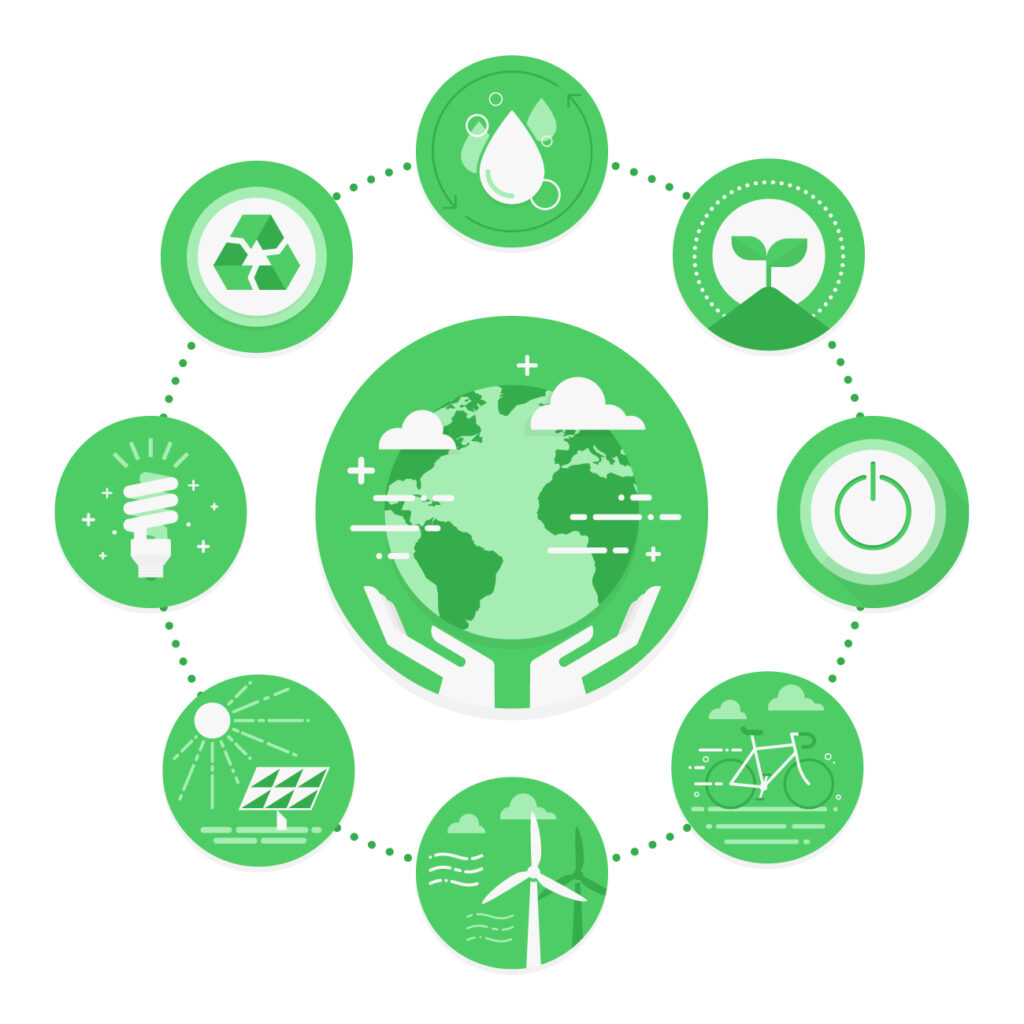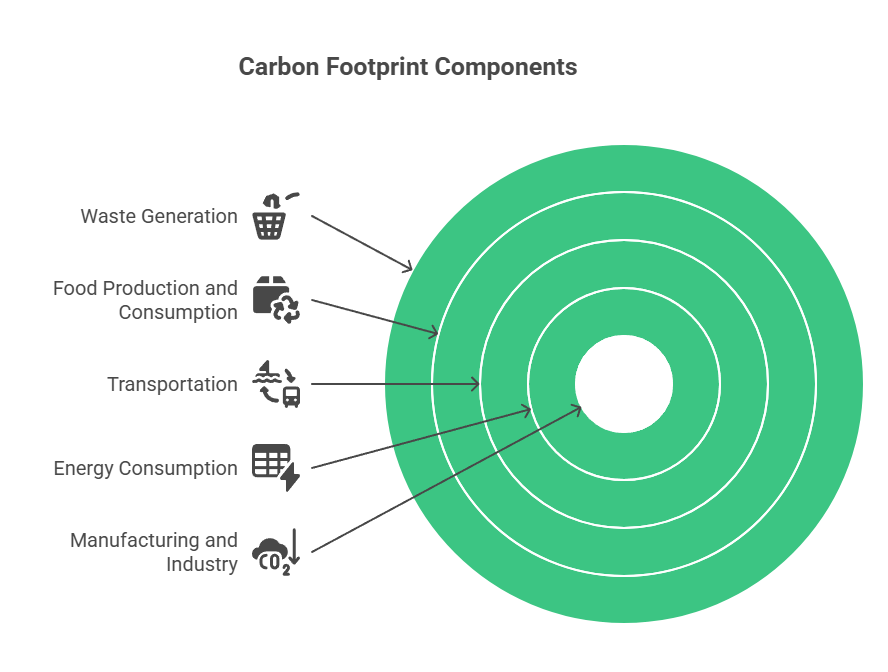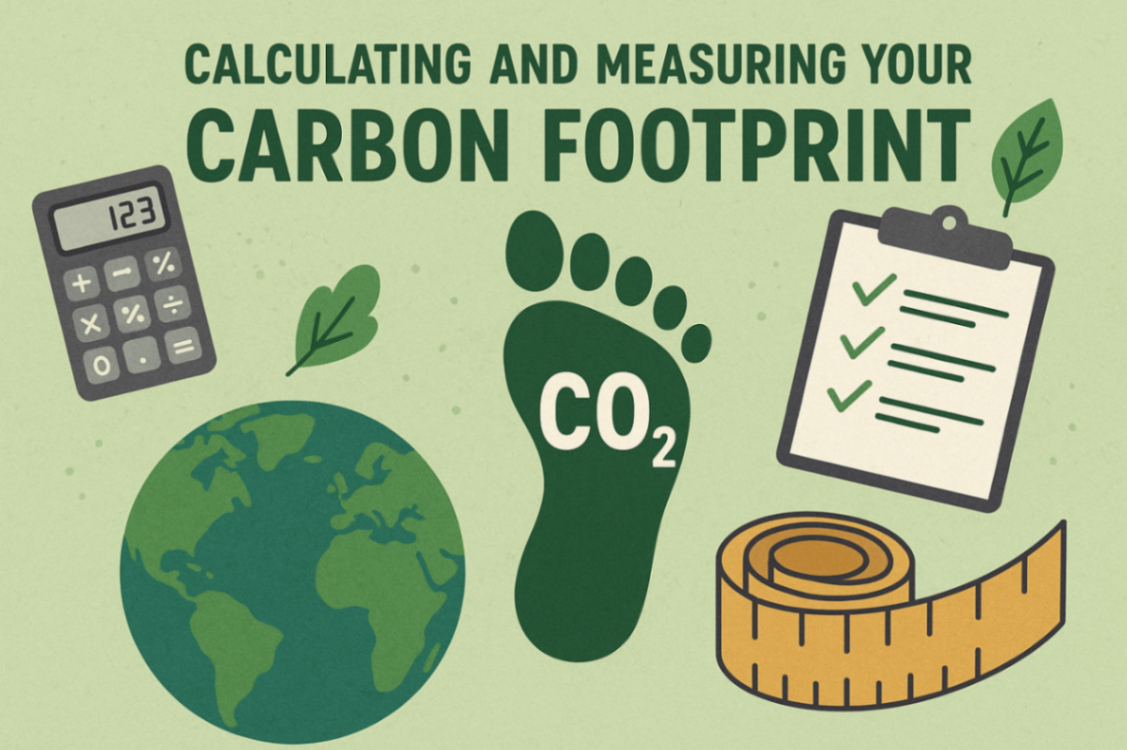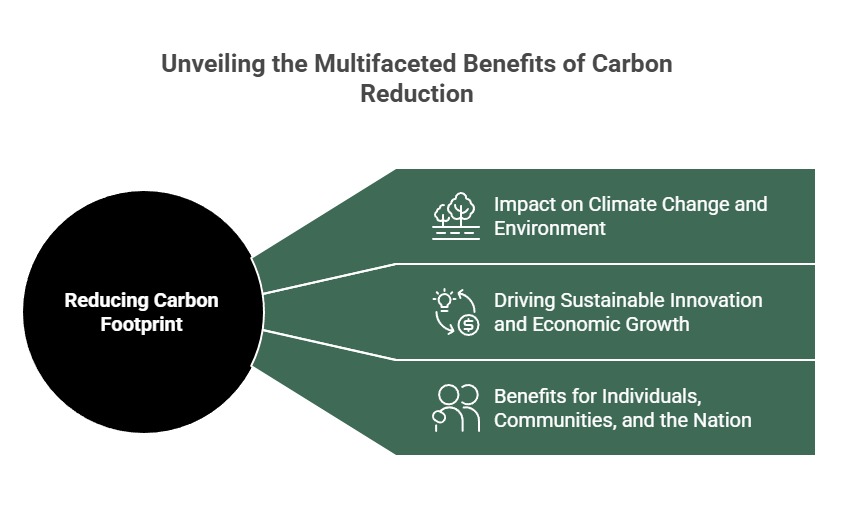| TL;DR
Carbon footprint is the total greenhouse gases you cause.It includes both direct (like driving) and indirect (like shopping) emissions. Home energy use adds emissions—save with efficient appliances and solar.Car and air travel emit a lot—public transport or biking is cleaner. Meat and imported food increase emissions—eat local and plant-based.Landfills release methane—composting and recycling reduce this. Factories use energy to make products—buy sustainable goods. Businesses and individuals can track emissions using online tools. Lowering your footprint helps fight climate change and pollution. It also saves money, boosts health, and supports green jobs. |
|---|
What Is a Carbon Footprint, Where Does It Come From, and Why Does It Matter Today?
Every action we take—charging a phone, cooking dinner, driving to work—leaves a trace, not on your calendar or bank account, but in the atmosphere. That invisible trail is your carbon footprint, and it’s one of the most critical numbers most people never think about.
Just like packaging is the first thing a customer touches, your carbon footprint is the last thing the planet deals with.
As per a study, the average American has an annual carbon footprint of approximately 16 metric tons of carbon dioxide equivalent (tCO₂e), which is nearly four times the global average of around 4 tCO₂e. This highlights the relatively high per capita greenhouse gas emissions in the United States compared to global standards.
And while the number may be invisible, its impact is not. Rising temperatures, stronger storms, vanishing coastlines—these are the results of our daily choices.
In the next section, we’ll break down exactly what contributes to your carbon footprint, where it came from, and how you can shrink it without shrinking your quality of life.
Ready to take that first step? Let’s dive in.
How Can You Better Understand Your Carbon Footprint?

A carbon footprint is not just a trendy phrase; it represents your environmental impact in the context of the United Nations Framework Convention. It quantifies the greenhouse gases—such as carbon dioxide, methane, and nitrous oxide—in metric tons, generated by your daily activities, which contribute to climate change and global warming potential.
These emissions originate from various sources, including driving cars, using electricity (especially from fossil fuels), heating and cooling homes, air travel, dietary choices (such as meat consumption), and the production, transportation, and disposal of goods.
By examining your carbon footprint, you can identify both direct emissions, like fuel combustion, and indirect emissions from goods produced elsewhere. Understanding these factors empowers you to take action against climate change, making a significant positive impact on our planet.
Your average carbon footprint in the United States represents the total amount of greenhouse gases you release into the atmosphere. These gases trap heat, causing the greenhouse effect, which drives global warming and accelerates climate change.
Activities like farming, transportation, and industrial production increase these emissions. Understanding the sources of emissions enables individuals and organizations to adopt more sustainable practices and minimize their environmental impact.
What Factors Add to Your Carbon Footprint?

Everyday actions can significantly impact your carbon footprint. From energy use to food production and waste, understanding these factors is crucial for making meaningful changes to protect our planet.
1. Energy Consumption
Energy consumption has a significant impact on our carbon footprint. Using fossil fuels for heating and electricity generation emits greenhouse gases, such as carbon dioxide. By improving energy efficiency and embracing renewable energy sources, particularly in electronic devices, we can reduce our carbon footprint. Understanding our energy use is vital in combating climate change and protecting our planet for future generations.
2. Transportation
Transportation significantly contributes to global carbon emissions, accounting for approximately 11-12% in India as of 2023 (Source). By opting for buses, trains, or biking, you can instantly reduce your carbon footprint. Every small choice counts—let’s embrace sustainable travel and make a positive impact on our climate together!
3. Food Production and Consumption
The way we produce and consume food, including various meat products, has a significant impact on an individual’s carbon footprint. Farming contributes to the release of greenhouse gases, such as carbon dioxide and nitrous oxide. By choosing sustainable practices and reducing meat consumption, we can lessen these emissions.
4. Manufacturing and Industry
The manufacturing and industry sectors significantly contribute to greenhouse gas emissions due to energy-intensive processes within the value chain. By adopting energy efficiency measures and conducting life cycle analysis and assessments, companies can identify sustainable practices, reduce their carbon footprint, and combat climate change. Join the movement towards a greener future—small changes can make a big difference!
5. Waste Generation
Waste generation significantly contributes to our carbon footprint and greenhouse gas emissions. As organic materials decompose, they release potent gases, such as carbon dioxide and methane. By recycling and composting, we can reduce these emissions, promote sustainable development, and combat global warming. Understanding this connection is crucial for the health of our planet.
Also read: Innovative Waste Management Solutions to Reduce Pollution and Promote Sustainability
How Do You Measure Your Carbon Footprint?

Measuring your carbon footprint involves assessing the emissions from daily activities like energy consumption and travel, which involve elements over which you have direct control, including the consumption of goods. This analysis converts those emissions into a single figure called the amount of carbon dioxide equivalents (CO2e), offering a clear view of your environmental impact.
Carbon footprint calculations can be simplified by organizations like the Environmental Protection Agency (EPA), the Nature Conservancy, and the World Wide Fund for Nature (WWF). By entering details such as energy usage or travel distance, you can identify your footprint and pinpoint areas for improvement, empowering you to make eco-friendly choices.
Common Calculation Methods
Carbon footprint calculations follow rules established by the Greenhouse Gas Protocol (GHG Protocol) from the International Organization. To calculate emissions in CO2, multiply the activity data by the corresponding emission factors, making it easy to see the carbon output of each activity. The table below lists the main standards:
| Scope | Nature of Emissions | Examples |
|---|---|---|
| Scope 1 | Direct carbon emissions refer to direct emissions | Burning fuel in boilers or vehicles |
| Scope 2 | Indirect emissions from the power you buy | Electricity used |
| Scope 3 | Other indirect emissions | Effects of Purchasing Raw Materials |
Ever analyzes the sources of your emissions, enabling you to make smarter, more responsible choices in how you consume and live.
Tools and Resources Available in India
India offers smart solutions to cut carbon footprints, with apps that track emissions for individuals and businesses. Greenworksbio provides biodegradable and compostable alternatives to conventional plastic products, such as bags, packaging, and cutlery. Their solutions help reduce plastic pollution and support eco-friendly lifestyles.
- U.N. Carbon Tracker: This is useful for tracking the carbon footprints of industries, similar to methodologies that may be reflected by research from the University of Michigan. It helps with finding and utilizing more efficient energy solutions.
- WWF Climate Calculator: This tool allows individuals to discover their daily carbon footprint. It gives ideas to help you choose greener habits.
- Tata Sustainability Tools: This supports businesses to be eco-friendly. It cuts down emissions in the supply chain.
All of these tools advance India’s transition to sustainable development. With the increased use of renewable energy, these tools make it simple for each of us to do our part in helping to meet environmental goals.
Why Reducing Carbon Footprint Matters?

Reducing our carbon footprints is vital for combating global warming. Join the movement—embrace sustainable habits and inspire others to protect our planet for a healthier future. Every choice matters!
1. How does reducing carbon footprints help slow down global warming?
Reducing carbon footprints helps slow global warming, preserving ecosystems and biodiversity. It improves air and water quality by cutting pollution from fossil fuels. Lower emissions also reduce the frequency and severity of extreme weather events.
2. How do individuals benefit from sustainability?
Reducing carbon footprints benefits individuals, communities, and the nation by promoting cleaner air, which leads to healthier lives and fewer respiratory issues. Embracing clean energy sources reduces pollution, conserves natural resources, and supports sustainable development. These actions protect the planet while inspiring a healthier, more resilient future for coming generations.
3. How does sustainability drive new innovations?
Reducing our carbon footprint is essential for a sustainable future. Adopting solar and wind energy helps businesses cut emissions while driving economic growth. Green technologies create jobs, reduce pollution, and support long-term environmental health. By making conscious choices today, we ensure a cleaner, more resilient planet for future generations.
Step Into a Greener Future with Greenworksbio
Embrace sustainability with Greenworksbio’s eco-friendly product range—biodegradable, compostable, and crafted for real-world impact. From everyday essentials to innovative packaging, our products help you reduce plastic waste and live more responsibly. Join the movement toward a cleaner, healthier planet and make green living simple, practical, and powerful. Contact us today.
Conclusion
Understanding your carbon footprint reduction is essential for personal and environmental well-being. Everyday activities like energy use, transportation, and food choices significantly impact emissions. By recognizing these sources, you can make small, meaningful changes that reduce your footprint. Adopting sustainable habits not only benefits your health and finances but also supports a cleaner, healthier planet for future generations.
Frequently Asked Questions
What are the main differences between carbon footprint and ecological footprint?
Carbon footprints measure greenhouse gas emissions, mainly in CO2 equivalents, from individuals or groups, including methane and nitrous oxide. In contrast, ecological footprints measure the amount of land required for daily activities. While carbon footprints focus on greenhouse gases, ecological footprints consider broader environmental impacts. Both are essential for promoting planetary stewardship.
How can individuals in India effectively reduce their carbon footprint?
Indians can reduce their carbon footprint by prioritizing energy efficiency, utilizing renewable energy, such as solar power, and opting for public transportation over cars. Choosing local and eco-friendly food also benefits the planet. These small changes align daily actions with environmental goals and help everyone.
Are there government initiatives in India to address carbon footprints?
India is actively reducing its carbon footprint through initiatives such as the National Action Plan on Climate Change (NAPCC) and programs promoting the use of renewable energy. These efforts aim to decrease greenhouse gas emissions, combat climate change, and foster sustainable development across various industries and communities.
How does lifestyle affect an individual’s carbon footprint?
A person’s lifestyle can significantly impact their carbon footprint. Most direct emissions originate from activities such as energy consumption, transportation, and purchasing goods. Carbon emissions become high when people use excessive energy or consume a large amount of meat. This can lead to an increase in greenhouse gases worldwide.

